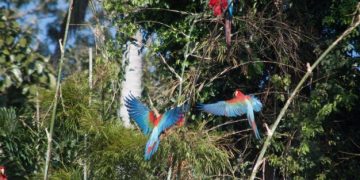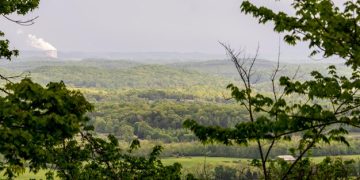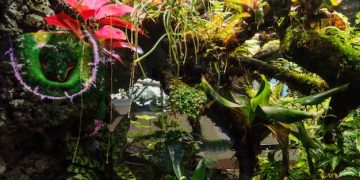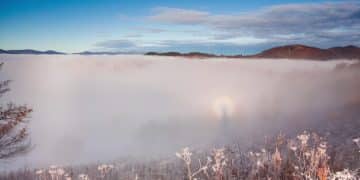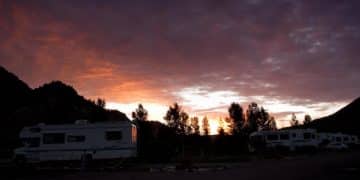The Ultimate Guide to Stargazing in Dark Sky National Parks
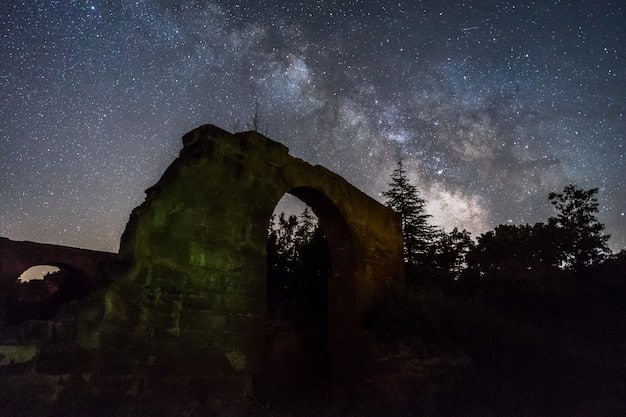
The Ultimate Guide to Stargazing in Dark Sky National Parks offers a comprehensive overview of the best locations, equipment, and techniques for experiencing the breathtaking beauty of the night sky within the protected environments of Dark Sky National Parks.
Immerse yourself in the cosmos with The Ultimate Guide to Stargazing in Dark Sky National Parks. Discover the best locations, necessary equipment, and essential tips for an unforgettable celestial experience.
Why Stargaze in Dark Sky National Parks?
Dark Sky National Parks offer unparalleled opportunities for stargazing due to their exceptionally dark skies. These parks actively minimize light pollution, providing ideal conditions for viewing celestial wonders far from urban interference.
The Importance of Dark Skies
Dark skies are crucial, not only for astronomy, but also for preserving nocturnal ecosystems and reducing energy waste. Dark Sky Parks advocate for responsible lighting practices to protect these valuable resources.
- Reduced light pollution allows for clearer views of stars and planets.
- Protected habitats for nocturnal wildlife.
- Energy conservation through efficient lighting.
- Enhanced opportunities for astronomical research and public education.
The benefits of preserving dark skies extend to human health, as exposure to excessive artificial light at night can disrupt sleep patterns and negatively impact overall well-being.
Ultimately, stargazing in these parks is not just a leisure activity, but a way to connect with nature and appreciate the importance of preserving dark skies for future generations.
Top Dark Sky National Parks in the US
Several National Parks in the US have been designated as International Dark Sky Parks, offering prime stargazing locations. Each park offers unique landscapes and exceptional viewing opportunities.
Arches National Park, Utah
Known for its stunning sandstone arches, Arches National Park also boasts remarkably dark skies. The contrast between the red rock formations and the starry sky creates a breathtaking visual experience.
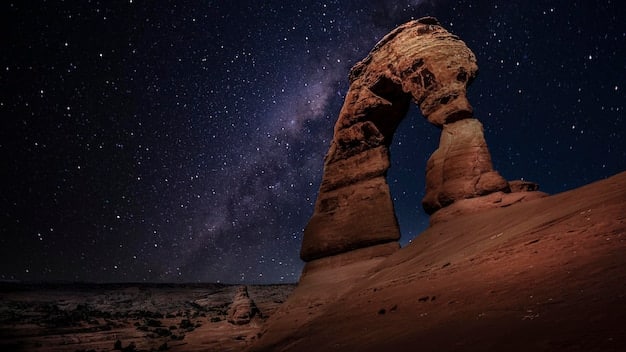
Bryce Canyon National Park, Utah
Bryce Canyon’s high elevation and remote location contribute to its exceptional darkness. The park regularly hosts astronomy programs and offers guided night hikes.
- Exceptional atmospheric transparency due to high altitude.
- Regular ranger-led astronomy programs.
- Guided night hikes available.
- Unique amphitheater landscape enhances the stargazing experience.
Bryce Canyon is renowned for its unique geology, making it a captivating destination for both day and nighttime exploration.
In conclusion, exploring Bryce Canyon’s dark skies brings a special blend of astronomical observation and nature appreciation, contributing to a memorable visit.
Essential Equipment for Stargazing
Having the right equipment can greatly enhance your stargazing experience. While sophisticated telescopes can provide detailed views, even basic equipment can significantly improve your observations.
Binoculars
Binoculars are a great starting point for stargazing, offering a wider field of view than telescopes and are easier to transport. Look for models with large objective lenses for better light gathering.
Telescopes
A telescope can bring distant celestial objects into closer view. Reflecting telescopes (Newtonian) are a good choice for beginners, offering a balance of aperture and affordability.
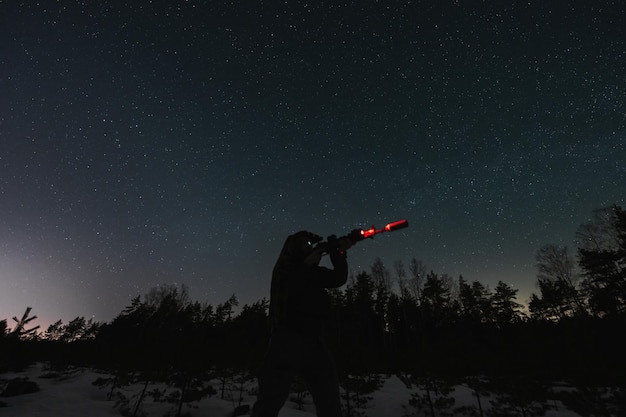
Other Useful Gear
Beyond optics, several other tools can enhance your comfort and viewing experience:
- Red flashlight to preserve night vision.
- Star chart or astronomy app to identify constellations and celestial objects.
- Warm clothing and blankets for comfort in cool night temperatures.
- A comfortable chair or mat for extended viewing periods.
Furthermore, a portable power bank can keep your devices running throughout the night, ensuring uninterrupted stargazing sessions.
Investing in the right equipment improves observation capabilities and allows for a deeper engagement with the night sky.
Tips for Planning Your Stargazing Trip
Careful planning is essential for a successful stargazing trip. Considerations include weather conditions, moon phases, and park regulations.
Check the Weather Forecast
Clear skies are crucial for stargazing, so monitor the weather forecast. Look for nights with minimal cloud cover and low humidity.
Consider the Moon Phase
The phase of the moon significantly impacts visibility. A new moon (when the moon is not visible) offers the darkest skies, while a full moon can wash out fainter celestial objects.
Respect Park Regulations
Familiarize yourself with park regulations regarding lighting, camping, and restricted areas. Adhere to these rules to protect the environment and ensure a safe experience.
Additionally, be mindful of wildlife and avoid disturbing their natural habitats during nighttime activities.
Proper planning is key to maximizing your enjoyment and appreciation of the night sky within Dark Sky National Parks.
Understanding Constellations and Celestial Objects
Learning about constellations and celestial objects can greatly enrich your stargazing experience. Familiarize yourself with basic astronomy concepts and common constellations.
Identifying Constellations
Use a star chart or astronomy app to locate and identify constellations. Start with prominent constellations like the Big Dipper and Orion, then branch out to more challenging ones.
Common Celestial Objects
Beyond stars, learn to identify planets, nebulae, and galaxies. Planets appear as bright, steady lights, while nebulae and galaxies are faint, fuzzy patches of light.
- Planets: Venus, Mars, Jupiter, Saturn
- Nebulae: Orion Nebula, Lagoon Nebula
- Galaxies: Andromeda Galaxy, Triangulum Galaxy
Furthermore, understanding astronomical events like meteor showers can add excitement to your stargazing sessions.
By expanding your knowledge of celestial objects, you transform a simple viewing into a cosmic exploration, filled with discovery.
Astrophotography Basics
Astrophotography allows you to capture the beauty of the night sky in stunning detail. While advanced techniques require specialized equipment, beginners can achieve impressive results with basic gear.
Equipment for Astrophotography
A DSLR or mirrorless camera with a wide-angle lens is a good starting point. A sturdy tripod is essential for long exposures.
Basic Techniques
Experiment with long exposures (several seconds to minutes) to capture faint light. Use a low ISO setting to minimize noise and a wide aperture to maximize light gathering.
- Use a remote shutter release to avoid camera shake.
- Focus manually on a bright star.
- Experiment with different exposure settings.
- Process your images in software like Adobe Lightroom or Photoshop.
Finally, combining multiple exposures (stacking) can further reduce noise and enhance detail in your astrophotography images.
With practice and patience, astrophotography can unlock a new dimension in your appreciation for the night sky.
| Key Point | Brief Description |
|---|---|
| 🔭 Dark Sky Parks | Minimize light pollution for ideal stargazing. |
| 🌌 Essential Gear | Binoculars, telescopes, red flashlight, star chart. |
| 🌙 Moon Phase | New moon offers the darkest skies for better visibility. |
| 📸 Astrophotography | Capture the night sky using long exposure techniques. |
Frequently Asked Questions
▼
Dark Sky National Parks minimize light pollution, providing exceptionally dark skies for optimal viewing of stars, planets, and other celestial objects. This allows for a clearer and more immersive stargazing experience.
▼
Essential equipment includes binoculars or a telescope, a red flashlight to preserve night vision, a star chart or astronomy app, warm clothing, and a comfortable chair. A camera with a tripod is useful for astrophotography.
▼
The moon’s brightness impacts visibility. A new moon (when the moon is not visible) offers the darkest skies, ideal for viewing faint objects. Full moons can wash out fainter stars and nebulae.
▼
Yes, respect park regulations regarding lighting, camping, and restricted areas. Avoid using white lights, stay on marked trails, and be mindful of wildlife. Always pack out everything you pack in.
▼
Common objects include planets (Venus, Mars, Jupiter), constellations (Orion, Big Dipper), nebulae (Orion Nebula), and galaxies (Andromeda Galaxy). Use a star chart or app to help identify them.
Conclusion
Exploring the night sky in Dark Sky National Parks offers a unique and awe-inspiring experience. With the right preparation and equipment, you can unlock the wonders of the universe and connect with nature in a profound way. Preserving these dark skies is crucial for future generations to continue enjoying the beauty of the cosmos.
